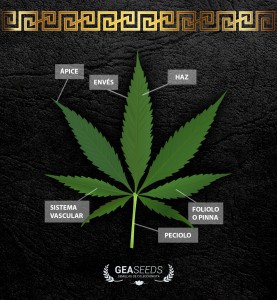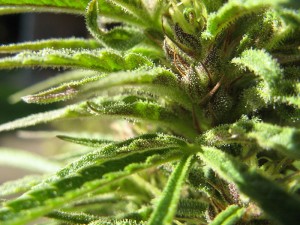Cannabis is a flowery, annual and dioic plant, which means that there are male marijuana plants (staminated) and females (pistilated).
Sometimes you can find hermaphroditic plants that have male and female sexual organs, so this type of plants pollinate themselves and produce flowers with seeds, in addition to transferring hermaphroditism in their genes, very annoying qualities for any grower.
Although there are many strains of cannabis, all plants have the same anatomy. The knowledge of this is very important when making a successful crop and understanding the behavior of the plant.
Parts of Cannabis:
1. Roots:
The root system is completely under the ground. It can be very large, almost like the whole plant, to allow access to groundwater. Obviously, when grown in pots or similar containers, the root system is smaller although this does not prevent the plant from surviving if it has everything it needs.
The roots are white and contain root hairs that are responsible for the absorption of water and nutrients. When the roots are brown is because the plant is not healthy and has some problem.
The main functions of the roots are anchoring the plant to the soil and absorbing water and nutrients, among others.
2. Stem:
The stem has the main function of transporting water and nutrients through the plant, in addition, it allows it to remain in an upright position and be able to support the weight of the branches and flowers. The parts of the stem from which the branches emerge are called knots and the parts of the stem between one knot and another are called internodes.
The length of the stem can range from 0.2 to 6 meters, although it usually does not exceed 3 meters..
It is very important that the stem of the plant be solid so that it is able to support the plant’s weight and carry nutrients properly. To promote stem strength, a fan can be used to focus on the plants so that it creates wind resistance and has a stronger stem.

Knot on the stem of the plant
3. Leaves:
Cannabis leaves have a very characteristic shape. They are palmately (imparipinnadas) with the sawn margins. During its growth, the number of pinnae or leaflets increases, reaching a maximum of 13. The more leaflets the leaf has, the healthier the plant.
The leaves fulfill very important functions in the plant because they are responsible for photosynthesis and perspiration, among others.

Parts of the cannabis leaf
The main parts of the leaves are:
- Beam: upper side of the leaf, receives light directly and is bright green in colour.
- Envelope: lower side of the leaf, contains most stomata and is light green in color.
- Petiole: is the corner that joins the leaf with the stem.
- Stipule: symmetrical leaf appendix located at the knots, at the base of the petiole.
- Leaflet or pinna: each separate part of the leaf blade. Cannabis has a composite leaf because it has several leaflets, and these are odd.
- Vascular system: these are the nerves of the leaves and transport nutrients through them.
4. Flowers:
Flowers are the most interesting part for every grower. In cannabis, the buds consumed are the flowers of the female plants, the flower is the reproductive organ of the plant, which is pollinated by wind. In cannabis, there are two types of flowers:
Male flowers:
are branched and have stamens where the pollen used to fertilize the female flowers is found.

Male flowers
Female flowers:
Female flowers are pistiled and have calyxes where the ovaries and stigmata are found. The parts of the female flowers are:
- Tail: is the bud at the end of the plant and is also known as the eye. At the top of the plant is the apical bud.
- Chalice: they are usually teardrop-shaped, and it is where the ovary is located. It has high concentrations of trichomes containing THC and other cannabinoids.
- Pistil: small hairs that are located in the chalice. In the beginning they are white in colour and become red, orange, yellow or brown as the plant matures.
- Trichomes: are microscopic glands in charge of producing the resin of flowers. They are found mainly in the flower but are also present to a lesser extent in the leaves and stems. Trichomes include cannabinoids and terpenes.

Flower female





Vince
Thanks for breaking this down! Very helpful for someone who just knows ‘cannabis’ and not all the individual parts.